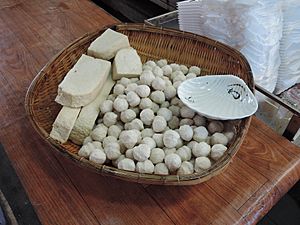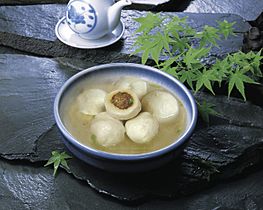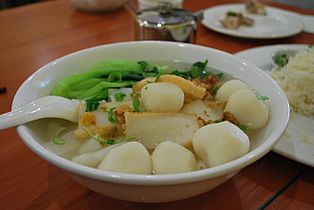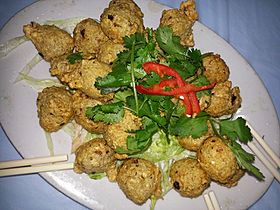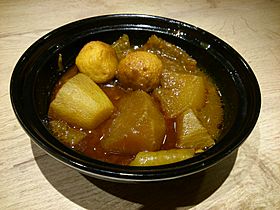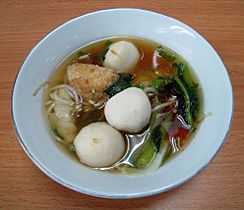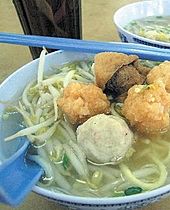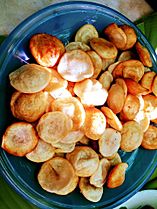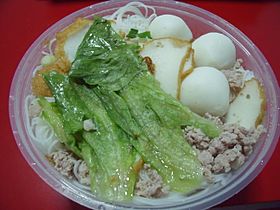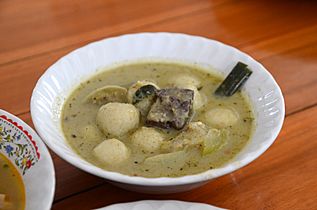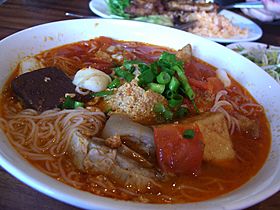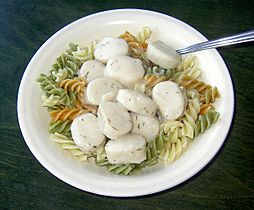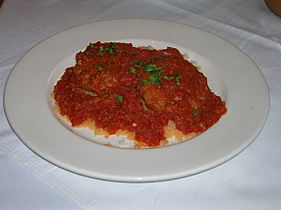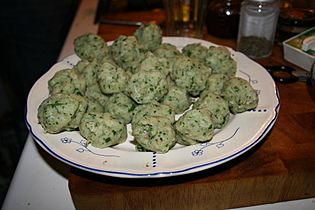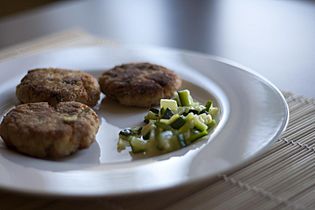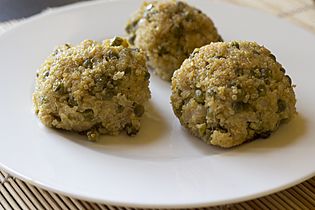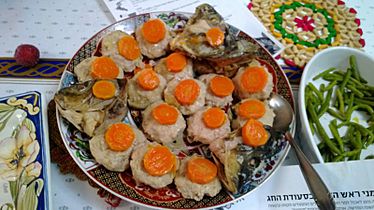Fish ball facts for kids
Quick facts for kids Fish ball |
|||||||||||||||||||||||||
|---|---|---|---|---|---|---|---|---|---|---|---|---|---|---|---|---|---|---|---|---|---|---|---|---|---|

Processed seafood, including (from left) fish balls, squid balls, prawn balls and crab sticks
|
|||||||||||||||||||||||||
| Traditional Chinese | 魚丸 | ||||||||||||||||||||||||
| Simplified Chinese | 鱼丸 | ||||||||||||||||||||||||
| Literal meaning | ulam | ||||||||||||||||||||||||
|
|||||||||||||||||||||||||
| Alternative Chinese name | |||||||||||||||||||||||||
| Traditional Chinese | 魚蛋 or 魚旦 | ||||||||||||||||||||||||
| Simplified Chinese | 鱼蛋 or 鱼旦 | ||||||||||||||||||||||||
| Literal meaning | fish egg | ||||||||||||||||||||||||
|
|||||||||||||||||||||||||
Fish balls are tasty, round snacks made from fish paste. They are usually boiled or deep fried. Fish balls are similar to fishcakes. They are often made from finely chopped fish, salt, and a special ingredient like tapioca flour or cornstarch that helps them stick together.
Fish balls are very popular in East and Southeast Asia. People eat them as a snack or add them to soups and hotpot dishes. They are thought to have come from Chinese cooking. Many fish ball businesses are run by people of Chinese background. In Europe, fish balls are often less processed. They sometimes use milk or potatoes to bind the ingredients. Nordic countries also have their own unique types of fish balls.
How Fish Balls Are Made
There are two main types of fish balls. They have different textures and are made in slightly different ways. They are also popular in different parts of the world.
Making Fish Balls in Asia
Even though the ingredients and methods are similar across Asian countries, there are small differences. These include how springy they are, their color, and their taste. For example, fish balls in Hong Kong and the Philippines can be firmer. They might also have a stronger fishy taste than those from Malaysia or Singapore. Taiwanese fish balls are very bouncy. They also have more air inside, which helps them soak up soups or sauces.
To make them, fish is usually shredded, ground, or pounded. Then, it is mixed for a long time with salt and crushed ice. This makes the mixture smooth. Other ingredients like sugar or starches are added. Water is also added to make sure the ball has a "soft, springy texture." This special way of mixing helps the fish proteins become firm and bouncy. In Taiwan, this perfect bouncy texture is called "Q".
For making many fish balls at once, machines shape them. The balls are then put in water at a warm temperature (30-45°C) to set. After that, they are boiled, cooled, and packaged. The setting time is important. It helps the fish balls keep their shape and look a bit see-through. Fish balls can be sold uncooked (after setting), boiled, or fried (after boiling).
The type of fish used can affect how fish balls turn out. This is because different fish react differently to heat. Making fish balls also helps use fish that might not be as expensive.
Making Fish Balls in Europe
Scandinavian fish balls are made from pureed fish, milk, and potato flour. They are shaped without much extra processing. This makes them softer. These fish balls often come in cans or plastic containers with broth or salty water. They also need time to set before being canned.
How Long Fish Balls Last
Fish balls can go bad. How long they last depends on how they are made and what is added to them. Uncooked fish balls last about 4 to 5 days if kept cold (5°C). A fried fish ball that has been marinated can last much longer, up to 135 days, if stored at about 4°C.
Checking What's Inside Fish Balls
Sometimes, what's on the label of processed seafood like fish balls isn't always what's inside. Studies have found that some fish balls might contain other seafood or even meat like pork or chicken. This is important for people with allergies. It's also important for those who follow special diets, like halal or kosher, which have rules about what meat can be eaten. Large, well-known companies usually label their products correctly. However, smaller producers, especially those selling to street vendors, might sometimes have different ingredients than expected.
Different Kinds of Fish Balls Around the World
Greater China
Fish Balls in Mainland China
Fish balls have a long history in China. Many people believe Chinese immigrants helped spread fish balls across Asia. In China, fish balls are made from fish paste, starch, egg white, fat, and flavorings like garlic and spring onion juice. They can also include other seafood or meats like beef or pork.
In Hubei, fish balls are made from freshwater fish. A special kind from Fuzhou has a minced pork filling inside the fish ball. The fish balls from Fuqing are much bigger. Some fish balls are even made from shark meat.
Fish Balls in Hong Kong and Macau
Fish balls are one of Hong Kong's most popular "street foods." People eat them plain or with a curry sauce. You can easily find them in markets and supermarkets. They are also a common ingredient in hot pot.
Fish like flathead mullet and daggertooth pike conger are often used. Originally, they might have been made from leftover fish. Today, most are imported and have a more consistent texture.
There are three main types of fish balls in Hong Kong and Macau: yellow, white, and golden. Yellow fish balls are the most common street food. White fish balls are larger and made from white fish, like Spanish mackerel. They are bouncy and fluffy with a strong fish taste. These are often served with noodles in Cháozhōu-style restaurants. They can also be found at some cha chaan tengs, which also sell beef balls and cuttlefish balls. Traditional white fish balls are often handmade from fresh fish. Golden fish balls are a snack from Cheung Chau. They are usually fist-sized and served with a special curry sauce. They are also made from fresh fish, which makes them very smooth.
Fish Balls in Taiwan
Milkfish balls are very common in Taiwan. The natural taste and texture of the milkfish give them a unique flavor. This is a popular way to eat the white meat of milkfish, which is plentiful but not always highly valued. Other fish used include shark, lizard fish, pike eel, and marlin.
Some fish balls in Taiwan have fish roe (eggs) inside. These are called fish balls with roe. They are often served at hot pot restaurants. They have a sweet and salty taste, and the roe pops in your mouth. There is also a fried golden version of these.
Southeast Asia
Fish Balls in Singapore
In Singapore, fish balls are also known as 鱼圆 (yú yuán) or 魚丸 (yú wán).
In the past, fish balls were made from local fish like coral fish and Dorab. Today, many are made from imported fish paste (surimi) mixed with fresh fish. Higher quality fish balls use fish like wolf herring, Spanish mackerel, and Conger eel.
Singapore eats a lot of fish balls, possibly more than any other country. People eat about 10 kg of fish balls per person each year. They can be served with soup and noodles, or with yong tau foo (stuffed tofu). They are also served with noodles called mee pok.
Bak chor mee, a popular Singaporean noodle dish, is often served with fish balls. It was even named a top street food by the World Street Food Congress. Fish balls can also be fried and served on a stick. They are the second most common processed fish product in Singapore.
-
Japanese fried fish balls
-
Fuzhou fish ball soup
-
Hakka fish ball rice noodle soup
-
A bowl of curry fish balls, pork rinds and radish sold in Hong Kong
Fish Balls in Indonesia
In Indonesia, fish balls are called bakso ikan. They are often served with tofu, vegetables, and fish otak-otak in a clear broth soup called tahu kok. Thin slices of fish balls can also be added to dishes like mie goreng (fried noodles), kwetiau goreng (fried flat noodles), nasi goreng (fried rice), and cap cai (stir-fried vegetables). A similar dish is pempek, where fish paste is shaped into logs and fried. Some fish ball soups include bakso kakap (snapper fish ball soup) from Semarang and bakso ikan marlin (sailfish fish ball soup) from Pesisir Barat, Lampung.
Fish Balls in Malaysia
In Malaysia, you can find fish ball dishes almost everywhere, especially at hawker stalls. Local people often eat Fish Ball Noodle (鱼丸粉) for breakfast, lunch, or dinner. In Malaysia, this dish is served in a clear soup or a "dry" version mixed with soy sauce. It is not spicy, so even children enjoy eating it.
Fish Balls in Brunei
In Brunei, fish balls are known as bebola ikan.
Fish Balls in the Philippines
In the Philippines, there are fish balls and a similar dish called bola-bola. Bola-bola is made from the same fish paste as fish cake, but it is wrapped in a thin wonton skin. Common ingredients include yellowtail fusilier, corn starch, and baking powder.
Fish Balls in Thailand
In Thailand, fish balls are often fried or grilled as snacks. In main meals, fish balls are added to Chinese-style noodle soups and curry dishes. An example is Kaeng khiao wan luk chin pla, which is a green curry with fish balls.
The most common fish used for Thai fish balls are threadfin bream, bigeye snapper, croaker, lizard fish, goatfish, and Pla krai (Chitala ornata).
-
Bakso ikan (fish balls) with tofu soup in Indonesia.
-
Deep-fried fish balls in a noodle soup from Kampar, Perak, Malaysia
-
Fried fish balls from the Philippines
-
Fish balls with vermicelli sold in Bukit Batok, Singapore
-
Thai Kaeng khiao wan luk chin pla, green curry with fish balls
-
Vietnamese bún riêu
Europe
Fish Balls in Northern Europe
In Sweden, fish balls are called Fiskbullar. In Norway and Denmark, they are called fiskeboller. These Nordic fish balls are white and do not have a breading.
- In Norway, fiskeboller are made with wheat and potato flour, milk, fish broth, salt, and seasonings. When canned, they are packed in fish broth. Haddock is a common fish used. They are usually served with potatoes, carrots, or cauliflower in a white sauce. This sauce is often made with the broth from the can. Sometimes, mild Madras curry seasoning is added to the sauce. Children often add ketchup to the sauce. Tiny fish balls called suppeboller (meaning "soup balls") are also common in fish soup. Sideboller are made from coal-fish.
- In Sweden, fiskbullar are usually served with mashed potatoes or rice, boiled green peas, and dill, caviar, or seafood sauces.
- Iceland has two types: Fiskbollur are very similar to those in Norway and Sweden. Fiskibollur are fried until brown in a pan. Both are served with boiled potatoes, carrots, lettuce, and either bechamel or Madras curry sauce.
- In the Faroe Islands, fish balls are called knettir. They are made with groundfish and mutton fat.
Fish Balls in Germany
German fish balls, called fischklößchen, often use many herbs and herb sauces.
Gefilte fish, a dish common in Ashkenazi Jewish cuisine, came from German cooking in the 14th century. It was originally a stuffed fish dish. It became popular for Jewish celebrations because it was an acceptable form of meat and already had the bones removed. This was helpful for rules about not picking through bones on the Sabbath. Jewish communities have their own versions based on local ingredients. For example, some add sugar in Poland, black pepper in Lithuania, or cook it in tomato sauce in Libya.
Fish Balls in England
A classic English (and American) type of fish ball uses cooked mashed potato and egg to bind the ingredients. It is then pan-fried. Cod is a popular fish for this style. A famous song called "The Lone Fish-ball" was published in 1855. It talks about this type of fish ball that was popular in New England.
Fish Balls in Italy
Italian fish balls, known as polpette di pesce, are fried with parmesan and breadcrumbs. They are usually served with a tomato sauce. You can find them as rounded balls or as flat patties.
-
Fiskbullar atop rotini pasta
-
Jewish fish balls in tomato sauce
-
Italian fish balls with crab and zucchini
-
Italian crab fish balls with quinoa
-
Jewish gefilte fish balls served during Rosh Hashanah
See also
 In Spanish: Bola de pescado para niños
In Spanish: Bola de pescado para niños


